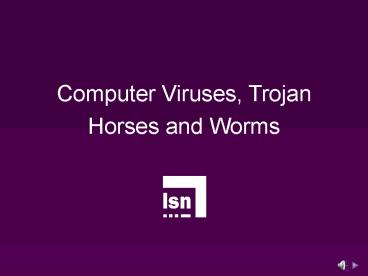Computer Viruses, Trojan Horses and Worms - PowerPoint PPT Presentation
1 / 12
Title: Computer Viruses, Trojan Horses and Worms
1
Computer Viruses, Trojan Horses and Worms
2
Most people have heard about computer viruses,
but not everybody understands what they
are
A computer virus is a self-replicating computer
program written to alter the way a computer
operates, without the permission or knowledge of
the user. Though the term is commonly used to
refer to a range of malware, a true virus must
replicate itself, and must execute itself. The
latter criteria is often met by a virus which
replaces existing executable files with a
virus-infected copy. While viruses can be
intentionally destructive destroying data, for
example some viruses are benign or merely
annoying. Wikipedia Oct 2006.
3
Trojan Horses are similar but do not
automatically replicate, and instead usually
spread by users opening malicious email
attachments or downloading and running an
infected file from the internet
Trojan Horses are impostor files that claim to
be something desirable but, in fact, are
malicious. Rather than insert code into existing
files, a Trojan horse appears to do one thing
(install a screen saver, for example) when in
fact it does something entirely different, and
potentially malicious, such as erase files.
Trojans can also open back doors so that computer
hackers can gain access to passwords, and other
personal information stored ona computer.
Wikipedia Oct 2006.
4
Yet another type of malware (malicious software)
are computer worms (known simply as worms), which
often spread without any user assistance
A computer worm is a self-replicating computer
program. It uses a network to send copies of
itself to other systems and it may do so without
any user intervention. Unlike a virus, it does
not need to attach itself to an existing program.
Worms always harm the network (if only by
consuming bandwidth), whereas viruses always
infect or corrupt files on a targeted computer.
Wikipedia Oct 2006.
5
From the point of view of an end user however,
viruses, trojan horses and worms all can infect
vulnerable computers and perform unwanted actions
on those systems. For example, among other
things, they may modify/delete files, open
security holes allowing hackers to gain access,
forward personal documents over the internet,
make substantial use of resources, or even cause
direct financial loss (such as by rerouting
internet dial up numbers to more expensive
services).
6
Luckily, protecting a system against most attacks
is generally not too difficult. The main solution
is to keep your system (and all applications in
it) up to date (use Windows Update). Also, use a
reputable Antivirus solution (these usually
protect against trojan horses and worms as well),
and put a good firewall in place, and perhaps
most importantly, to be cautious and sceptical
about anything obtained from third parties (such
as opening email attachments or downloading
dubious files).
7
The rest of this tutorial will concentrate on
antivirus solutions, as keeping a system up to
date and setting up a firewall have been
addressed in other tutorials. Before that
however, we will make a few important points
about attachments and file downloads, giving a
few guidelines that will help you avoid becoming
an easy target.
8
First of all, note that like spam, a lot of
malware arrives via email. The messages may
purport to come from someone you know (and though
not necessarily, this may well be the case, that
someones computer having been infected). The
emails may even seem semi-personally crafted (and
they keep getting better), making it plausible
that they are genuine. If in doubt check them up
with the sender, scan them (making sure that your
antivirus software is up to date), and if
unsatisfied, perform an internet search for them,
PRIOR to opening them. For a quick tutorial to
good practice select the link below
- email borne malaware
view
9
Note however that it is always crucial that your
system and antivirus software is always up to
date. New viruses emerge on a regular basis, and
antivirus companies are always playing catch up,
constantly releasing new virus definition files
(used to identify viruses), hence the more up to
date your antivirus product is, the less
vulnerable it should be. Similarly, new
vulnerabilities are constantly being discovered
in operating systems and software, and quickly on
the trail, new malware to exploit them, and new
patches to fix them. So keep your system and
software up to date to reduce your risk of
infection.
10
With all this in mind, below you can find a list
of short tutorials about the common tasks that
you may need to perform with your antivirus
solution. Select the links below to view the
tutorials
- checking for updates
- performing a manual scan
- configuring antivirus settings
view
view
view
Note This does not represent the endorsement of
particular products, nor does it recommend these
products in favour of other ones. The tutorials
are simply used to illustrate the simple steps
that are likely to be needed with most antivirus
tools. More information and links are provided in
the last page.
11
The following set of recommendations will help
you keep your computer safe
- Keep your system and software up to date
- Use antivirus, firewall and antispyware
solutions - Do not open unsafe attachments
- Keep away from chain letters, spam and too
good to be true offers - Keep away from dubious web sites
- Beware of receiving files from people in chat
rooms - Beware of hoaxes (do a search for them if
suspicious) - Beware of unsafe file sharing programs
12
The following is a list of links to some of the
major sites about virus, trojan horses and worms
information and tools
- Computer Viruses Wikipedia
- Antivirus Software Wikipedia
- Protect Your Computer by Microsoft
- AVG Anti-virus
- McAfee
- Panda ActiveScan
- Sophos
- Symantec
x































